Holger Blume
Improved Multi-Scale Grid Rendering of Point Clouds for Radar Object Detection Networks
May 25, 2023



Abstract:Architectures that first convert point clouds to a grid representation and then apply convolutional neural networks achieve good performance for radar-based object detection. However, the transfer from irregular point cloud data to a dense grid structure is often associated with a loss of information, due to the discretization and aggregation of points. In this paper, we propose a novel architecture, multi-scale KPPillarsBEV, that aims to mitigate the negative effects of grid rendering. Specifically, we propose a novel grid rendering method, KPBEV, which leverages the descriptive power of kernel point convolutions to improve the encoding of local point cloud contexts during grid rendering. In addition, we propose a general multi-scale grid rendering formulation to incorporate multi-scale feature maps into convolutional backbones of detection networks with arbitrary grid rendering methods. We perform extensive experiments on the nuScenes dataset and evaluate the methods in terms of detection performance and computational complexity. The proposed multi-scale KPPillarsBEV architecture outperforms the baseline by 5.37% and the previous state of the art by 2.88% in Car AP4.0 (average precision for a matching threshold of 4 meters) on the nuScenes validation set. Moreover, the proposed single-scale KPBEV grid rendering improves the Car AP4.0 by 2.90% over the baseline while maintaining the same inference speed.
Improved Calibration Procedure for Wireless Inertial Measurement Units without Precision Equipment
Jul 11, 2022



Abstract:Inertial measurement units (IMUs) are used in medical applications for many different purposes. However, an IMU's measurement accuracy can degrade over time, entailing re-calibration. In their 2014 paper, Tedaldi et al. presented an IMU calibration method that does not require external precision equipment or complex procedures. This allows end-users or personnel without expert knowledge of inertial measurement to re-calibrate the sensors by placing them in several suitable but not precisely defined orientations. In this work, we present several improvements to Tedaldi's method, both on the algorithmic level and the calibration procedure: adaptions for low noise accelerometers, a calibration helper object, and packet loss compensation for wireless calibration. We applied the modified calibration procedure to our custom-built IMU platform and verified the consistency of results across multiple calibration runs. In order to minimize the time needed for re-calibration, we analyzed how the calibration result accuracy degrades when fewer calibration orientations are used. We found that N=12 different orientations are sufficient to achieve a very good calibration, and more orientations yielded only marginal improvements. This is a significant improvement compared to the 37 to 50 orientations recommended by Tedaldi. Thus, we were reduced the time required to calibrate a single IMU from ca. 5 minutes to less than 2 minutes without sacrificing any meaningful calibration accuracy.
Self-Supervised Velocity Estimation for Automotive Radar Object Detection Networks
Jul 07, 2022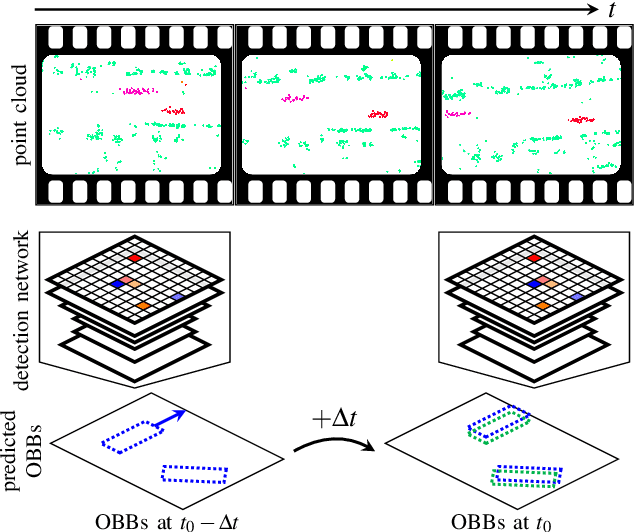
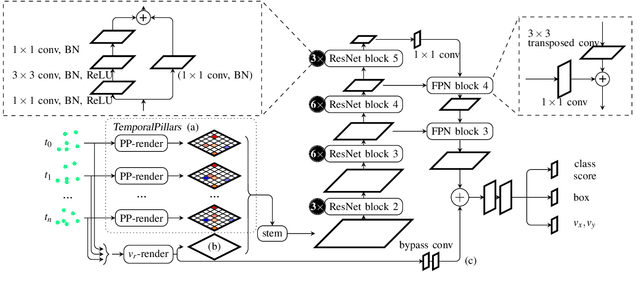
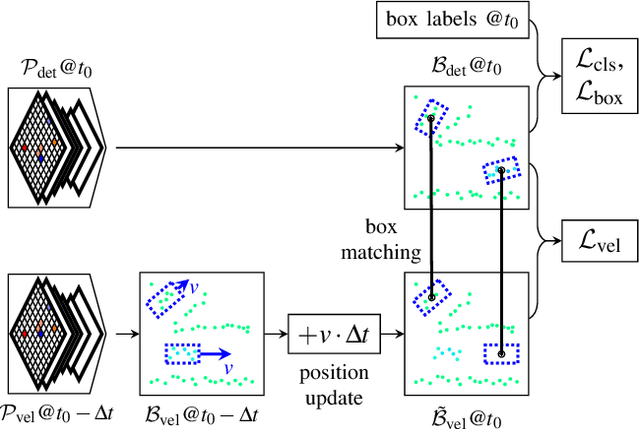
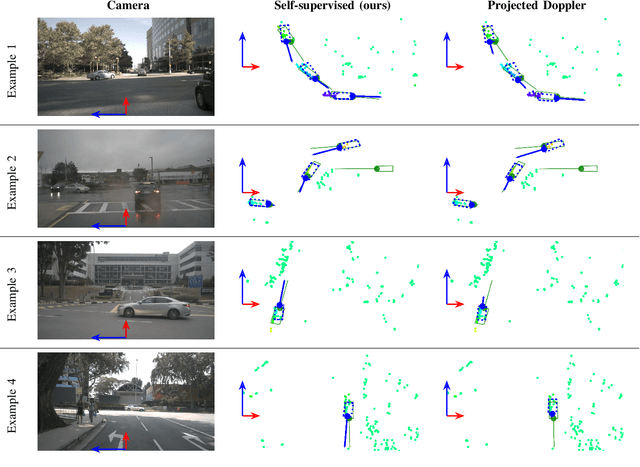
Abstract:This paper presents a method to learn the Cartesian velocity of objects using an object detection network on automotive radar data. The proposed method is self-supervised in terms of generating its own training signal for the velocities. Labels are only required for single-frame, oriented bounding boxes (OBBs). Labels for the Cartesian velocities or contiguous sequences, which are expensive to obtain, are not required. The general idea is to pre-train an object detection network without velocities using single-frame OBB labels, and then exploit the network's OBB predictions on unlabelled data for velocity training. In detail, the network's OBB predictions of the unlabelled frames are updated to the timestamp of a labelled frame using the predicted velocities and the distances between the updated OBBs of the unlabelled frame and the OBB predictions of the labelled frame are used to generate a self-supervised training signal for the velocities. The detection network architecture is extended by a module to account for the temporal relation of multiple scans and a module to represent the radars' radial velocity measurements explicitly. A two-step approach of first training only OBB detection, followed by training OBB detection and velocities is used. Further, a pre-training with pseudo-labels generated from radar radial velocity measurements bootstraps the self-supervised method of this paper. Experiments on the publicly available nuScenes dataset show that the proposed method almost reaches the velocity estimation performance of a fully supervised training, but does not require expensive velocity labels. Furthermore, we outperform a baseline method which uses only radial velocity measurements as labels.
Improved Orientation Estimation and Detection with Hybrid Object Detection Networks for Automotive Radar
May 03, 2022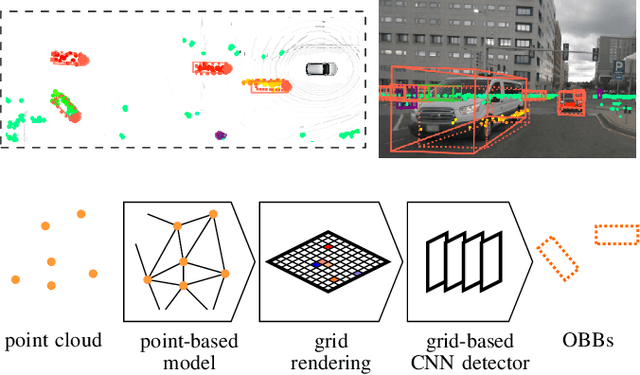
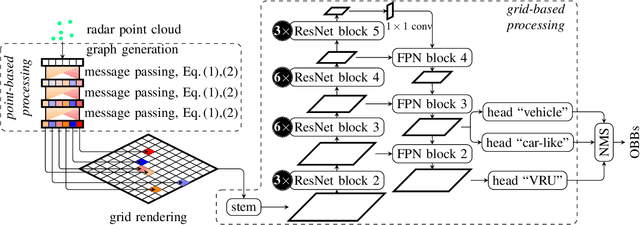
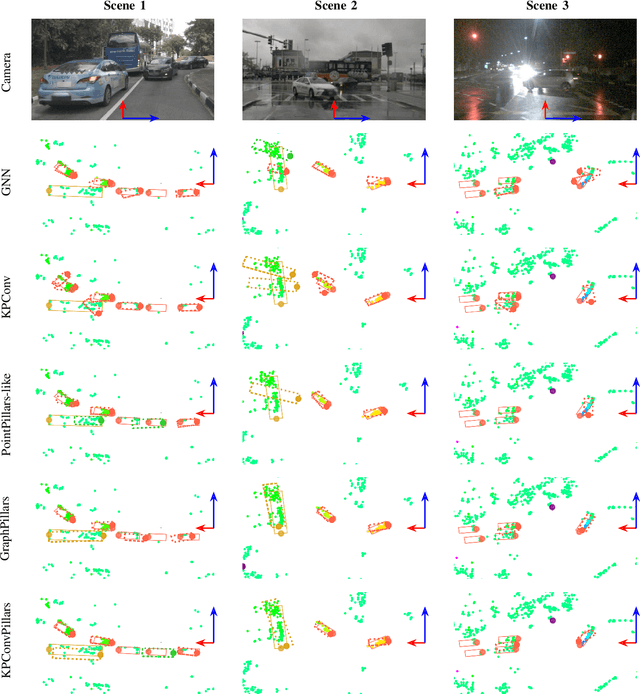

Abstract:This paper presents novel hybrid architectures that combine grid- and point-based processing to improve the detection performance and orientation estimation of radar-based object detection networks. Purely grid-based detection models operate on a bird's-eye-view (BEV) projection of the input point cloud. These approaches suffer from a loss of detailed information through the discrete grid resolution. This applies in particular to radar object detection, where relatively coarse grid resolutions are commonly used to account for the sparsity of radar point clouds. In contrast, point-based models are not affected by this problem as they continuously process point clouds. However, they generally exhibit worse detection performances than grid-based methods. We show that a point-based model can extract neighborhood features, leveraging the exact relative positions of points, before grid rendering. This has significant benefits for a following convolutional detection backbone. In experiments on the public nuScenes dataset our hybrid architecture achieves improvements in terms of detection performance and orientation estimates over networks from previous literature.
 Add to Chrome
Add to Chrome Add to Firefox
Add to Firefox Add to Edge
Add to Edge